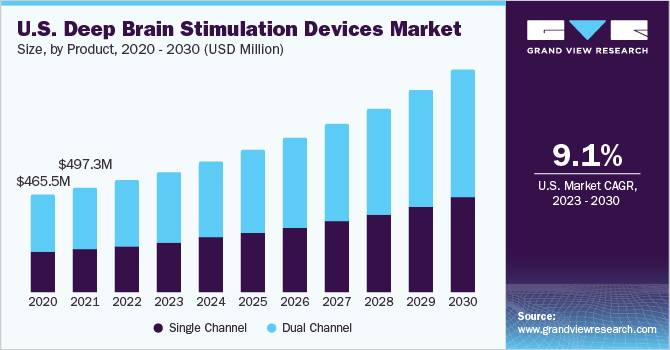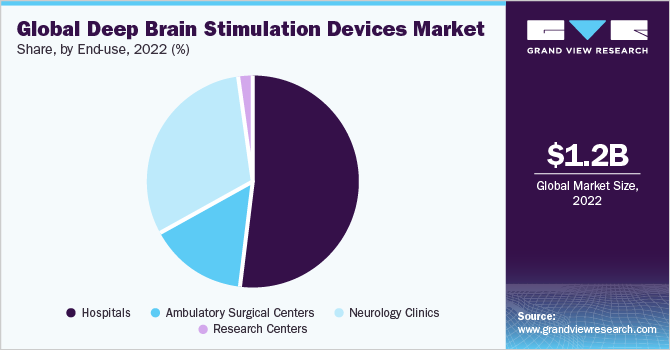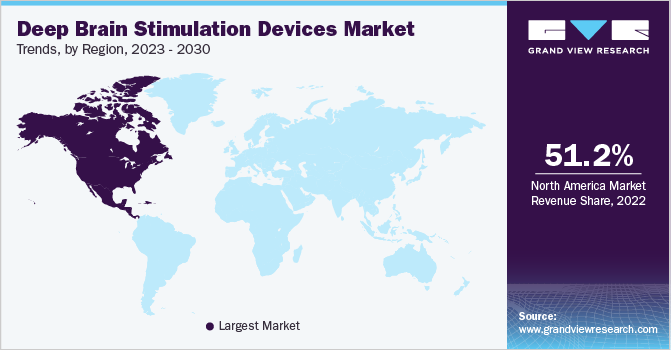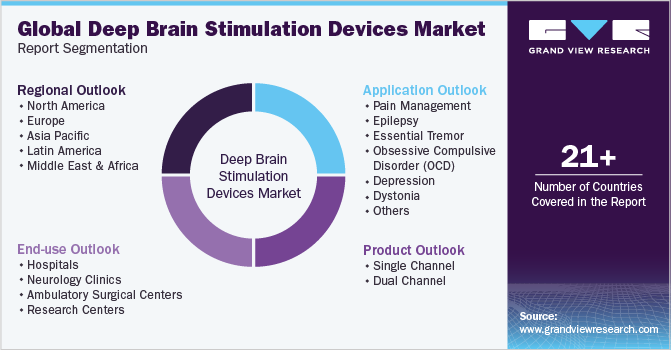- Home
- »
- Medical Devices
- »
-
Deep Brain Stimulation Devices Market Size Report, 2030GVR Report cover
![Deep Brain Stimulation Devices Market Size, Share & Trends By Product (Single-channel, Dual-channel), By Application (Parkinson’s Disease, Epilepsy), By End-use (Hospitals, ASCs), By Region (Asia Pacific, North America), And Segment Forecasts, 2023 - 2030Report]()
Deep Brain Stimulation Devices Market Size, Share & Trends By Product (Single-channel, Dual-channel), By Application (Parkinson’s Disease, Epilepsy), By End-use (Hospitals, ASCs), By Region (Asia Pacific, North America), And Segment Forecasts, 2023 - 2030
- Report ID: 978-1-68038-335-5
- Number of Report Pages: 130
- Format: PDF, Horizon Databook
- Historical Range: 2018 - 2021
- Forecast Period: 2023 - 2030
- Industry: Healthcare
Report Overview
The global deep brain stimulation devices market size was estimated at USD 1.18 billion in 2022 and is expected to grow at a compound annual growth rate (CAGR) of 9.9% from 2023 to 2030. Major factors driving the market growth include the rising geriatric population, the introduction of technologically advanced products, escalating product demand as add-on therapy, an increasing incidence of chronic diseases, such as migraine and epilepsy, and the presence of highly unmet medical needs in these disease segments. The rising prevalence of neurological disorders and lifestyle-related disorders will further drive the market growth. For instance, according to the World Stroke Organization (WSO) global stroke fact sheet for 2022, there are over 12.2 million new stroke cases reported annually worldwide.

Furthermore, this data reveals that globally, one in every four individuals aged 25 years or older is expected to experience a stroke during their lifetime. These sobering statistics underscore the critical importance of addressing stroke prevention and treatment on a global scale. Thus, due to such factors, the market is expected to grow rapidly in the near future. Moreover, external funding for R&D, collaboration, FDA approval, and demand for minimally invasive surgeries are other major factors propelling the market growth. For instance, in April 2022, a significant trial was initiated at Southmead Hospital in Bristol, featuring a novel miniaturized deep brain stimulation (DBS) device known as the Picostim DBS system. The primary objective of this study is to mitigate complications and reduce the costs typically associated with DBS surgery by introducing and testing this innovative device.
Moreover, the introduction of this new device holds the potential to streamline existing DBS surgery, making it not only quicker but also safer and more cost-effective. This promising development could ultimately broaden access to DBS therapy, benefiting a larger segment of individuals dealing with Parkinson's disease by making the treatment more accessible and affordable. Thus, due to such activities, the demand for DBS devices will increase in the near future. The increasing prevalence of neurological disorders, such as Parkinson’s disease, essential tremor, dystonia, and epilepsy, is a high-impact rendering driver for the market. According to the WHO, neurological diseases contribute 6.3% to the global disease burden and are one of the major causes of mortality worldwide, resulting in 13.2% of deaths in developed countries and 16.8% in low- and middle-income countries.
High mortality and disease burden create clinical urgency for the incorporation of long-term solutions, such as DBS. Furthermore, growing awareness about the massive neurological disease burden has raised the demand for deep brain stimulators as an alternative therapy. This is expected to drive market growth during the forecast period. Furthermore, technological advancements in DBS technologies are anticipated to create growth opportunities in this market. These technological improvements include multi-target stimulation, robot-assisted implantation, improved microelectrode designs, rechargeable implantable pulse generators, and personalized directed programming. For instance, in July 2022, Abbott revealed that its deep brain stimulation (DBS) system had received Breakthrough Device Designation from the U.S. FDA.
This designation is granted to investigate the application of the DBS system in treating treatment-resistant depression (TRD), a severe subtype of major depressive disorder (MDD). This recognition underscores the importance of Abbott's innovative approach in addressing a challenging and critical medical condition, opening up the potential for accelerated advancements in the field of depression treatment. Countries, such as the U.S. and Canada, have witnessed a high prevalence rate of movement and psychiatric disorders coupled with the rising geriatric population. For instance, according to the Parkinson's Foundation, symptoms of PD are common at an average age of 60. The geriatric population is highly susceptible to these disorders. Similarly, according to the Canadian Psychological Association, around 2% of the population is suffering from obsessive-compulsive disorder.
Product Insights
Based on product, the market is segmented into single-channel and dual-channel DBS devices. The dual-channel segment is dominating the market with a share of 57.0% in 2022 owing to its higher adoption in surgical procedures. Dual-channel devices represent some of the most secure and efficient tools employed in surgical interventions. Consequently, the surge in disabling neurological conditions' prevalence, the escalating demand for Parkinson's disease (PD) surgeries, and the rising adoption of dual-channel Deep Brain Stimulation (DBS) devices by a growing number of medical facilities have all contributed to the remarkable growth of this segment. Furthermore, the segment's expansion is being fueled by ongoing technological advancements and the introduction of new products. However, the single-channel DBS device segment is expected to grow at the highest CAGR from 2023 to 2030.
The consensus among healthcare experts is that single-channel DBS devices provide an extensive array of programming options for neurologists, consequently boosting their appeal and usage. Supporting this trend, the Parkinson's Foundation highlights the increased vulnerability of the geriatric population to neurological ailments. As per the WHO Report 2022, by 2050, the global population of individuals aged 60 years and older will double to 2.1 billion, while those aged 80 years and above will triple to reach 426 million by 2050, compared to 2020 figures. Given the increasing geriatric demographic, coupled with the rising patient awareness regarding neurological conditions, and the strong preference exhibited by healthcare professionals, the growth trajectory of this segment is expected to experience a significant upswing.
Application Insights
On the basis of application, the Parkinson's disease segment dominated the market with a share of 65.0% in 2022. This is due to the increasing number of U.S. FDA approvals for deep brain stimulation therapies, the high prevalence of PD worldwide, and an increasing number of research and development activities. For instance, in March 2023, researchers at Michigan Technological University embarked on a groundbreaking initiative, leveraging neuromorphic computing to enhance both the efficacy and energy efficiency of DBS systems utilized in the treatment of Parkinson's disease. This innovative approach is poised to significantly propel the growth of this segment in the years ahead. However, the epilepsy segment is expected to grow at the fastest CAGR from 2023 to 2030.
The increasing awareness about advanced epilepsy treatment options, combined with the ongoing development of healthcare infrastructure is expected to increase the growth of the segment in the near future. As per the 2023 World Health Organization (WHO) report, approximately 50 million individuals are currently suffering from epilepsy, making it one of the most prevalent neurological disorders globally. Furthermore, it is noteworthy that nearly 80% of individuals with epilepsy reside in low- and middle-income countries. Given the limitations of medication in addressing seizures and the less favorable success rates associated with surgical interventions, DBS has emerged as a valuable therapeutic approach in epilepsy management. This evolving landscape in epilepsy treatment is expected to significantly bolster the growth of this segment, offering promising prospects for improving the quality of life for those affected by this neurological condition.
End-use Insights
The hospitals end-use segment dominated the overall market with a share of 51.7% in 2022. The substantial growth witnessed in this segment can predominantly be attributed to the rising number of DBS surgeries performed within hospital settings and the concurrent rise in the prevalence of conditions, such as Parkinson's disease and essential tremor. In addition, the availability of technologically advanced DBS devices, coupled with favorable reimbursement policies, is poised to further propel the segment growth during the forecast period. A notable example of this is Medtronic, which offers comprehensive services aimed at securing and maintaining coverage, as well as facilitating payment for a range of DBS devices.

However, the Ambulatory Surgical Centers (ASC) segment is expected to grow at the highest CAGR from 2023 to 2030 due to lower cost of procedures as compared to hospitals, convenient access for patient care, reduced waiting time, and low infection rate as compared to neurology clinics and hospitals. Furthermore, according to a study conducted by Advancing Surgical Care, 92% of patients were satisfied with the medical care and service provided in the ASCs, thus boosting the segment growth. Most of the neurosurgeries can now be performed at ASCs, as surgical procedures undertaken here are advanced and less invasive. Thus, shorter procedure time and ongoing advancements in minimally invasive surgical techniques are among the key factors driving the segment growth.
Regional Insights
North America dominated the market with a share of 51.2% in 2022 owing to the increase in government funding and initiatives for raising awareness about Parkinson’s disease (PD) is expected to drive the demand for deep brain stimulators. Furthermore, the presence of major competitors, the availability of sophisticated healthcare infrastructure, and supportive government initiatives are also responsible for the market growth in this region. For instance, the National Institute of Neurological Disorder and Stroke (NINDS) supports research activities related to DBS to determine its safety and effectiveness in the treatment of PD. However, Asia Pacific is expected to significantly lead the market from 2023 to 2030.

The region’s growth is attributed to the rising prevalence of neurodegenerative disorders coupled with unmet demand for effective and long-term solutions. Rising awareness about neurological disease treatment options and improvements in the clinical development framework of emerging economies are also expected to drive market growth in this region. Moreover, the presence of high growth opportunities in developing countries, such as Japan, China, and India, is likely to contribute to market growth. The establishment of organizations, such as the Asia Pacific Centre for Neuromodulation (APCN), which was founded to conduct research and promote awareness about the associated benefits of DBS, is anticipated to boost regional market growth.
Key Companies & Market Share Insights
Key players operating in this industry are increasingly focusing on product launches, technological advancements, and other growth strategies, such as mergers & acquisitions to strengthen their foothold in the market. For instance, in July 2023, Boston Scientific Corp. made a noteworthy announcement regarding the FDA approval of its Vercise Neural Navigator 5 Software. This innovative software, when integrated with the Vercise Genus DBS systems, is poised to provide clinicians with essential data for optimizing treatment for individuals living with Parkinson's disease or essential tremor. This advancement is set to enhance the precision and effectiveness of DBS therapy, benefiting patients dealing with these neurological conditions. Some of the key players operating in the global deep brain stimulation devices market include:
-
Abbott (St. Jude Medical)
-
Medtronic
-
Boston Scientific Corporation
-
Aleva Neurotherapeutics S.A.
-
Nexstim
-
LivaNova PLC
-
Neuropace Inc.
Deep Brain Stimulation Devices Market Report Scope
Report Attribute
Details
Market size value in 2023
USD 1.28 billion
Revenue forecast in 2030
USD 2.50 billion
Growth rate
CAGR of 9.9% from 2023 to 2030
Base year for estimation
2022
Historical data
2018 - 2021
Forecast period
2023 - 2030
Report updated
September 2023
Quantitative units
Revenue in USD million/billion and CAGR from 2023 to 2030
Report coverage
Revenue forecast, company ranking, competitive landscape, growth factors, and trends
Segments covered
Product, application, end-use, region
Regional scope
North America; Europe; Asia Pacific; Latin America; MEA
Country scope
U.S.; Canada; UK; Germany; France; Italy; Spain; Denmark; Sweden; Norway; Japan; China; India; Australia; South Korea; Thailand; Brazil; Mexico; Argentina; South Africa; Saudi Arabia; UAE; Kuwait
Key companies profiled
Abbott (St. Jude Medical); Medtronic; Boston Scientific Corp.; Aleva Neurotherapeutics S.A.; Nexstim; LivaNova PLC; Neuropace Inc.
Customization scope
Free report customization (equivalent up to 8 analysts working days) with purchase. Addition or alteration to country, regional & segment scope
Pricing and purchase options
Avail customized purchase options to meet your exact research needs. Explore purchase options
Global Deep Brain Stimulation Devices Market Report Segmentation
This report forecasts revenue growth and provides an analysis of the latest trends in each of the sub-segments from 2018 to 2030. For this study, Grand View Research has segmented the deep brain stimulation devices market report on the basis of product, application, end-use, and region:

-
Product Outlook (Revenue, USD Million, 2018 - 2030)
-
Single Channel
-
Dual Channel
-
-
Application Outlook (Revenue, USD Million, 2018 - 2030)
-
Pain Management
-
Epilepsy
-
Essential Tremor
-
Obsessive Compulsive Disorder (OCD)
-
Depression
-
Dystonia
-
Parkinson’s Disease
-
Others
-
-
End-use Outlook (Revenue, USD Million, 2018 - 2030)
-
Hospitals
-
Neurology Clinics
-
Ambulatory Surgical Centers
-
Research Centers
-
-
Regional Outlook (Revenue, USD Million, 2018 - 2030)
-
North America
-
U.S.
-
Canada
-
-
Europe
-
Germany
-
UK
-
France
-
Italy
-
Spain
-
Denmark
-
Norway
-
Sweden
-
-
Asia Pacific
-
Japan
-
China
-
India
-
Australia
-
South Korea
-
Thailand
-
-
Latin America
-
Brazil
-
Mexico
-
Argentina
-
-
Middle East and Africa (MEA)
-
South Africa
-
Saudi Arabia
-
UAE
-
Kuwait
-
-
Frequently Asked Questions About This Report
b. The global deep brain stimulation devices market size was estimated at USD 1.18 billion in 2022 and is expected to reach USD 1.28 billion in 2023.
b. The global deep brain stimulation devices market is expected to grow at a compound annual growth rate of 9.9% from 2023 to 2030 to reach USD 2.50 billion by 2030.
b. North America dominated the deep brain stimulation devices market with a share of 51.24% in 2022. This is attributable to the rising prevalence of movement and psychiatric disorders coupled with the increasing geriatric population in the region.
b. Some of the key players operating in the deep brain stimulation devices market include Medtronic, Boston Scientific Corporation, Abbott, and Aleva, and Neurotherapeutics SA.
b. Key factors that are driving the deep brain stimulation devices market growth include the increasing incidence of neurological diseases, preference for a targeted approach, and technological advancements.
Share this report with your colleague or friend.
![gvr icn]()
NEED A CUSTOM REPORT?
We can customize every report - free of charge - including purchasing stand-alone sections or country-level reports, as well as offer affordable discounts for start-ups & universities. Contact us now
![Certified Icon]()
We are GDPR and CCPA compliant! Your transaction & personal information is safe and secure. For more details, please read our privacy policy.
We are committed towards customer satisfaction, and quality service.
"The quality of research they have done for us has been excellent."





